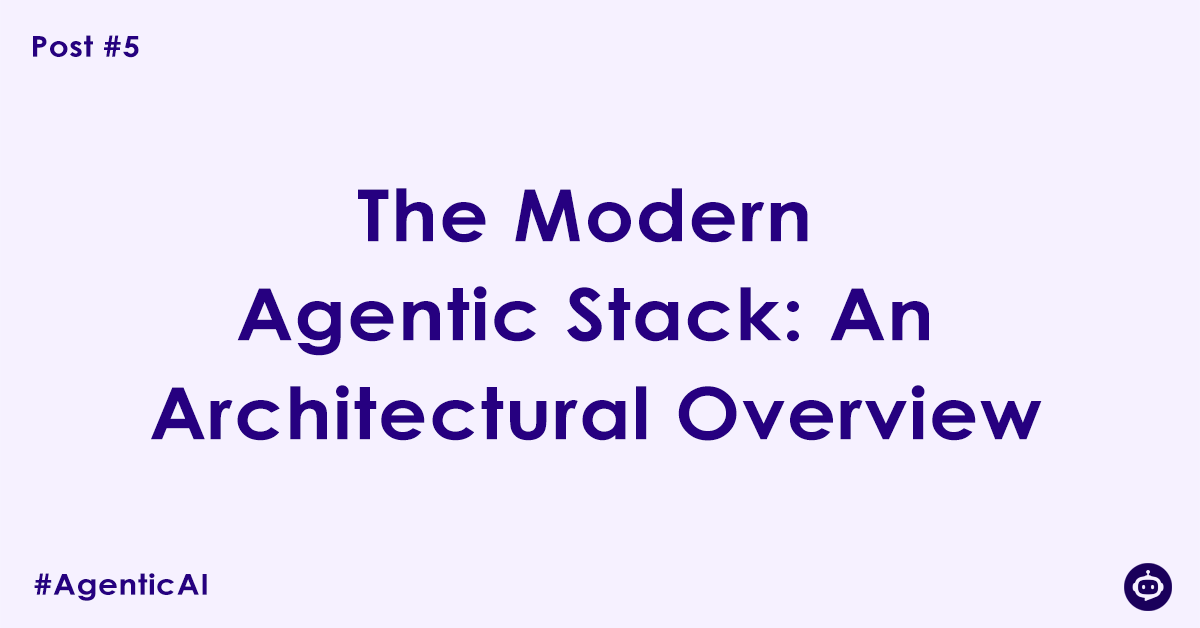So far in our series, we’ve defined what an AI agent is and traced its history. Now, it’s time to pop the hood and look at the engine. How is a modern, sophisticated AI agent actually built?
It’s tempting to think of an agent as a single, monolithic piece of code. The reality is far more interesting. A capable agent is a system, an architecture of specialized components working in concert. This collection of technologies is often referred to as the agentic stack.
Think of it like a master artisan’s workshop. You don’t just have a brilliant artisan (the AI model); you also need a workbench, a set of tools, a library of reference books, and a way to track progress. Let’s break down the components of the modern agent’s workshop.
The Agentic Stack: A High-Level Diagram
Before we dive into each piece, here’s a visual representation of how they all fit together:
+-----------------------------------------------------------------+
| |
| USER GOAL |
| |
+-----------------------------------------------------------------+
|
v
+-----------------------------------------------------------------+
| AGENT FRAMEWORK |
| (The Orchestrator / Nervous System) |
| |
| +---------------+ +----------------------+ |
| | |----->| | |
| | LLM CORE |<-----| VECTOR DATABASE | |
| | (The Brain) | | (Long-Term Memory) | |
| | |----->| | |
| +---------------+ +----------------------+ |
| ^ | |
| | | |
| v | +----------------------+ |
| +---------------+ | | |
| | |<---->| TOOL APIs | |
| | TOOL USE | | (Hands & Senses) | |
| | MODULE | | | |
| +---------------+ +----------------------+ |
| |
+-----------------------------------------------------------------+
|
v
+-----------------------------------------------------------------+
| |
| COMPLETED TASK |
| |
+-----------------------------------------------------------------+
... and observing the entire process:
+-----------------------------------------------------------------+
| MONITORING SERVICES |
+-----------------------------------------------------------------+
1. The LLM Core: The Brain of the Operation
At the heart of every modern agent is a powerful Large Language Model (LLM). This is the cognitive engine responsible for reasoning, understanding, and planning.
- What it does: The LLM Core interprets the user’s high-level goal, breaks it down into a sequence of logical steps, synthesizes information from various sources, and generates the final output. It’s the source of the agent’s “intelligence.”
- Analogy: The Brain or the CEO. It doesn’t perform every task itself, but it does all the thinking, planning, and delegating.
- Examples: OpenAI’s GPT-4, Google’s Gemini, Anthropic’s Claude 3, Meta’s Llama 3.
2. Agent Frameworks: The Nervous System
An LLM on its own is just a brain in a jar. An Agent Framework provides the structure and orchestration needed to connect that brain to the rest of the components, enabling it to act.
- What it does: These frameworks provide the code scaffolding to manage the agent’s main loop (think, plan, act, observe). They simplify complex tasks like managing memory, chaining calls to the LLM, and integrating tools.
- Analogy: The Nervous System or the Operating System. It carries messages between the brain, memory, and tools, ensuring everything works together seamlessly.
- Examples: LangChain, LlamaIndex, Autogen.
3. Vector Databases: The Long-Term Memory
An LLM’s built-in memory is limited to the current conversation. To give an agent a persistent, long-term memory, we use a vector database.
- What it does: A vector database stores information (like documents, past conversations, or user data) as numerical representations called “embeddings.” This allows the agent to search for and retrieve information based on conceptual or semantic similarity, not just keywords. This is the technology that powers Retrieval-Augmented Generation (RAG).
- Analogy: A specialized, searchable library or a long-term memory. The agent can instantly recall relevant past experiences or consult vast amounts of documentation to inform its current task.
- Examples: Pinecone, Chroma, Weaviate, FAISS.
4. Tool APIs: The Hands and Senses
To be useful, an agent must be able to interact with the outside world. Tools, exposed via Application Programming Interfaces (APIs), are what give the agent the ability to take real action.
- What it does: Tools allow the agent to perform tasks beyond text generation. This could be searching the web, sending an email, accessing a company’s internal database, running a piece of code, or connecting to another AI service. The agent’s LLM core decides when and how to use a specific tool to achieve a sub-task.
- Analogy: The Hands, Eyes, and Ears. They are the agent’s connection to the digital and physical world, allowing it to perceive information and manipulate its environment.
- Examples: Google Search API, Twilio API for sending messages, a Python interpreter for running code, internal company APIs for accessing customer data.
5. Monitoring Services: The Health Monitor
Once an agent is deployed, especially in a business-critical application, you need to know what it’s doing, how well it’s performing, and what it’s costing.
- What it does: Monitoring services track the agent’s behavior, log the decisions it makes, trace the sequence of LLM calls and tool usage, and flag errors. This is crucial for debugging, evaluating performance, and managing operational costs.
- Analogy: A vital signs monitor or an aircraft’s black box. It provides the essential data needed to understand the agent’s health and performance, ensuring it operates reliably and efficiently.
- Examples: LangSmith (from LangChain), Arize AI, Weights & Biases.
Conclusion: From Model to Agent
An effective AI agent is far more than just a powerful LLM. It is a carefully architected system where a reasoning core is connected to memory, tools, and a robust operational framework. By understanding this modern agentic stack, we move from being simple users of AI to becoming architects of intelligent, autonomous systems.
Author

Experienced Cloud & DevOps Engineer with hands-on experience in AWS, GCP, Terraform, Ansible, ELK, Docker, Git, GitLab, Python, PowerShell, Shell, and theoretical knowledge on Azure, Kubernetes & Jenkins. In my free time, I write blogs on ckdbtech.com
